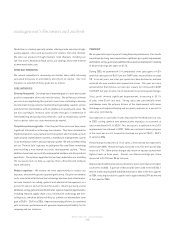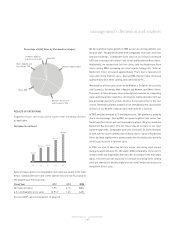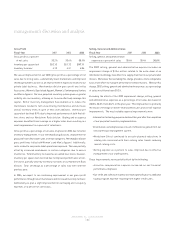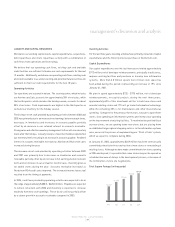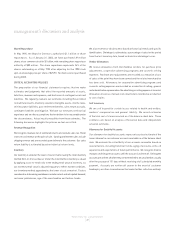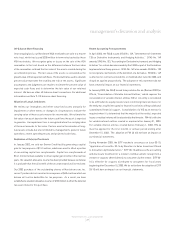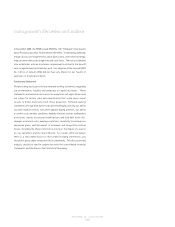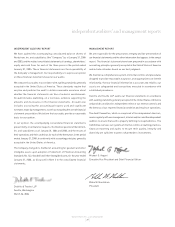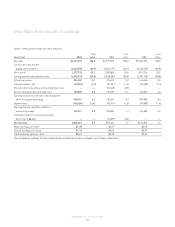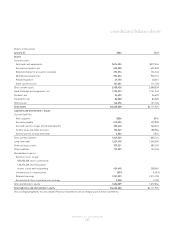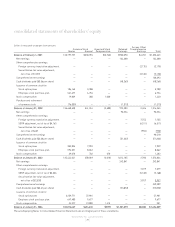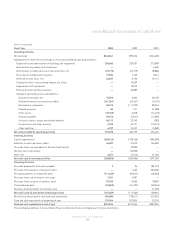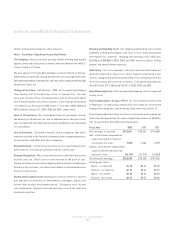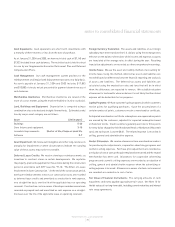Nordstrom 2003 Annual Report Download - page 24
Download and view the complete annual report
Please find page 24 of the 2003 Nordstrom annual report below. You can navigate through the pages in the report by either clicking on the pages listed below, or by using the keyword search tool below to find specific information within the annual report.NORDSTROM, INC. and SUBSIDIARIES
[22 ]
management’s discussion and analysis
Share Repurchase
In May 1995, the Board of Directors authorized $1.1 billion of share
repurchases. As of January 31, 2004, we have purchased 39 million
shares of our common stock for $1 billion, with remaining share repurchase
authority of $82 million. The share repurchase represents 24% of the
shares outstanding as of May 1995 after adjusting for the 1998 stock
split, at an average price per share of $25.93. No shares were repurchased
during 2003.
CRITICAL ACCOUNTING POLICIES
The preparation of our financial statements requires that we make
estimates and judgments that affect the reported amounts of assets,
liabilities, revenues and expenses, and disclosure of contingent assets and
liabilities. We regularly evaluate our estimates including those related
to doubtful accounts, inventory valuation, intangible assets, income taxes,
self-insurance liabilities, post-retirement benefits, sales return accruals,
contingent liabilities and litigation. We base our estimates on historical
experience and on other assumptions that we believe to be reasonable under
the circumstances. Actual results may differ from these estimates. The
following discussion highlights the policies we feel are critical.
Revenue Recognition
We recognize revenues net of estimated returns and exclude sales tax. Retail
stores record revenue at the point of sale. Catalog and Internet sales include
shipping revenue and are recorded upon delivery to the customer. Our sales
return liability is estimated based on historical return levels.
Inventory
Our inventory is stated at the lower of cost or market using the retail inventory
method (first-in, first-out basis). Under the retail method, inventory is valued
by applying a cost-to-retail ratio to the ending retail value of inventory. As
our inventory retail value is adjusted regularly to reflect market conditions,
our inventory method approximates the lower of cost or market. Factors
considered in determining markdowns include current and anticipated demand,
customer preferences, age of the merchandise and fashion trends.
We also reserve for obsolescence based on historical trends and specific
identification. Shrinkage is estimated as a percentage of sales for the period
from the last inventory date, based on historical shrinkage losses.
Vendor Allowances
We receive allowances from merchandise vendors for purchase price
adjustments, cooperative advertising programs and cosmetic selling
expenses. Purchase price adjustments are recorded as a reduction of cost
of sales at the point they have been earned and the related merchandise
has been sold. Allowances for cooperative advertising programs and
cosmetic selling expenses are recorded as a reduction of selling, general
and administrative expense when the advertising or selling expense is incurred.
Allowances in excess of actual costs incurred are recorded as a reduction
to cost of sales.
Self Insurance
We are self insured for certain losses related to health and welfare,
workers' compensation and general liability. We record estimates
of the total cost of claims incurred as of the balance sheet date. These
estimates are based on analysis of historical data and independent
actuarial estimates.
Allowance for Doubtful Accounts
Our allowance for doubtful accounts represents our best estimate of the
losses inherent in our customer accounts receivable as of the balance sheet
date. We evaluate the collectibility of our accounts receivable based on
several factors, including historical trends, aging of accounts, write-off
experience and expectations of future performance. We recognize finance
charges on delinquent accounts until the account is written off. Delinquent
accounts are written off when they are determined to be uncollectible, usually
after the passage of 151 days without receiving a full scheduled monthly
payment. Accounts are written off sooner in the event of customer
bankruptcy or other circumstances that make further collection unlikely.




